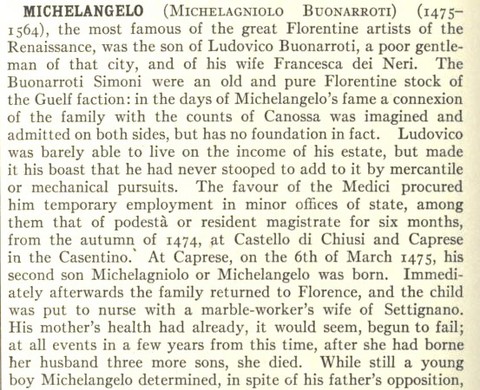1911年版ブリタニカ(ブリタニカ百科事典第11版) 1911 Encyclopedia Britannica (11th Ed.) [辞書・辞典・事典類]
Did you ever hear of Michael Angelo?
He was a famous artist who lived in Italy in the Middle Ages. Everybody in English Literature seemed to know about him, and the whole class laughed because I thought he was an archangel. He sounds like an archangel, doesn't he? The trouble with college is that you are expected to know such a lot of things you've never learned. It's very embarrassing at times. But now, when the girls talk about things that I never heard of, I just keep still and look them up in the encyclopedia. (Jean Webster, Daddy-Long-Legs [New York: Century, 1912])
(ミケル・アンジェロってお聞きになったことありますか?
中世にイタリアに住んでいた有名な芸術家です。英文学のクラスに出ているひとは、みんなこのひとのことを知っているらしくて、わたしが大天使だと思ったというのでクラス全部が笑いました。彼って大天使みたいに聞こえるでしょ? 大学で困ることは、習ったことのないたくさんのことを当然知っているものと思われることです。ときどきえらくバツが悪い思いをします。でも今では女の子たちがわたしの聴いたことのないことを話しているときは、ただじっと黙っていて、あとから百科事典で調べることにしています。――『あしながおじさん』1年生10月10日)

1913 advertisement for the eleventh edition of The Encyclopædia Britannica image via "Encyclopædia Britannica Eleventh Edition," Wikipedia <http://en.wikipedia.org/wiki/Encyclop%C3%A6dia_Britannica_Eleventh_Edition>
前に、ミケランジェロ (英 Michelangelo)の名前のつづりがよくわからない、ということを書きました。どういうことかというと、一方で、『あしながおじさん』の1年生10月10日の手紙にある "Michael Angelo" という分かち書きの問題があったのですけれど、それはとりあえず歴史的には解決、しかしもう一方で、ヘルマン・グリムからの英訳書のミケランジェロ自身のものと思われる自署つき frontispiece のキャプションにある、MICHEL AGNIOLO DI BONARROTI という、え!、angel はどこに?、 という綴りの問題があったのです。
で、Agniolo はまだわからんのですけれど、記事に引いたInternet Archive のブリタニカ百科事典第11版(1910-11)をあとから見たら、見出し語のところで MICHELAGNIOLO (一語)がカッコの中にはいっていました。――
本文を読んでも、"At Caprese, on the 6th of March 1475, his second son Michelangniolo or Michelangelo was born" というところに出てくるだけで、結局わからんです。ちなみに平凡社の大百科事典 (1985) (これは外国語の原語が索引にあるので便利、ということもあって、好きなんです)では、Michelangelo の a にアクセント記号(アクサン・グラーヴ)がついて Michelàngelo Buonarroti となっています(第14巻321ページ)。これの典拠はナニ?
ということで謎は未解決のままです。
が、この伝説的なブリタニカ百科事典第11版にあらためて萌えました。仕事場にブリタニカ(たぶん1970年代くらい)があるのですけれど、場所をとるので廊下のロッカーに詰め込んで、おかげで掃除の人はたぶんロッカーを移動できない(重くて)のですが、辞書・事典類は、どこに置いてあるかで使ったり使わなかったりするということはあるでしょうし、ブログにリンクしておけばうまく使えるのではなかろうかとw。トイレに置いて全巻読破する、というのも夢なのですが、そんなにのんびりしていられません。
で、Internet Archive の e-text を全巻並べておいて、1巻ずつとりだしてパラパラ検索、という、本に近い古典的形態も考えられますが――ほんとはそれやってもいいのですけれど、どれがどの巻なのかわからないのでめんどくさいです・・・・・・つうか、だからこそどれがどの巻かわかるように並べるのは意味あるかもしれないですね、ヒマができたらやってみまーす――この古典的ブリタニカをまとめているサイトがあるので、それでよしとします。1911年版はアナキズムで知られるクロポトキンが記事を寄稿していることでも知られるのかも知れないけれど、そんなことは知ったことではないです。最良のブリタニカ百科として知られておるのです。
Classic Encyclopedia: Based on the 11th Edition of the Encyclopedia Britannica (pub. 1911) [1911 Encyclopedia Britannica - Free Online] main page: <http://www.1911encyclopedia.org/Main_Page>
このメイン・ページは Subject 科目が見出しリスト化されています。100 科かどうかはわかりませんが。場所→ヨーロッパ→イギリス諸島→イングランド→ロンドンみたいに階層化され、それぞれからカテゴリーやサブカテゴリーや記事の一覧にリンクしています。
全体のデザインはウィキペディアを模しているみたいです。同じ位置に検索パネルがあります。でもウィキペディアと違ってていいなあ、と思うのは、大文字小文字の区別とか、人名の場合フルネームでじゃないとうまく出てこないとか、いうことがなくて、それなりに検索がかかることでしょうか。ブリタニカではなくて LoveToKnow のもろもろの情報ページを検索する ("AllLoveToKnow") こともできます(いまのところ興味ないですけど)。
MICHELAGNIOLO を検索してみると、上に引いたMichelangelo の項目("Michelangelo - LoveToKnow 1911") にだけ出てくる語だということがわかりました。
・・・・・・ま、しょうがないですネ。
記事のテクストにハイパーリンクがあるのもウィキペディアと同じです。
☆ ☆ ☆
dresser を引いてみると、フランス語の dressoir が元と書いてありました。えっ、アメリカニズムじゃなかったの!――
DRESSER, in furniture, a form of sideboard. The name is derived from the Fr. dressoir, a piece of furniture used to range or dresser the more costly appointments of the table. The appliance is the direct descendant of the credence and the buffet, and is, indeed, a much more legitimate inheritor of their functions than the modern sideboard, which, as we know it, is practically an i 8th-century invention. It developed into its present shape about the second quarter of the 17th century, and has since then changed but little. As a piece of movable furniture it was made rarely, if at all, after the beginning of the 19th century until the revival of interest in what is called "farmhouse furniture" at the very beginning of the 10th century led in the first place to the construction of many imitation antique dressers from derelict pieces of old oak, and especially from panels of chests, and in the second to the making of avowed imitations. The dresser conformed to a model which varied only in detail and in ornament. Its simple and agreeable form consisted of a long and rather narrow table or slab, with drawers or cupboards beneath and a tall upright closed-in back arranged with a varying number of shallow shelves for the reception of plates; hooks for mugs were often fixed upon the face of these shelves. Towards the end of the z 7th century small cupboards were often added to the superstructure. The majority of these dressers were made of oak, but when, early in the Georgian period vzir. z 9 mahogany came into general use, they were frequently inlaid with that wood; holly and box were also used for inlaying, most frequently in the shape of plain bands or lines. [. . .]
"18th century" が "i 8th-century" となっていたり、他にも文字が化けているところがあります。まだ不完全なのですね。
window seat を引いてみると、つぎのような説明がありました。――
WINDOW SEAT, a miniature sofa without a back, intended to fill the recess of a window. In the latter part of the 18th century, when tall narrow sash windows were almost universal, the window seat was in high favour, and was no doubt in keeping with the xxviii. 2 3 a formalism of Georgian interiors. It differed much in decorative detail, but little in form. It stood as high from the floor as a chair; the two ends were identical, with a roll-over curve, more or less pronounced. The seats and ends were usually upholstered in rich fabrics which in many cases have remained intact. The legs followed the fashion in chairs and were square and tapered, or, somewhat later, round and reeded. Hepplewhite and the brothers Adam designed many graceful window seats, but they were produced by all the cabinet-makers of the period.
やっぱり文字が違っているところがあるようです。
・・・・・・・・・・
・・・・・・・・・
ま、いっか。
念のためはじめてウィキペディアで Window seat を引いたら、最初の段落はまるごと1911年版ブリタニカから取られていました。――
Window seat
From Wikipedia, the free encyclopedia
A window seat is a miniature sofa without a back, intended to fill the recess of a window. In the latter part of the 18th century, when tall narrow sash windows were almost universal, the window seat was in high favor, and was no doubt in keeping with the formalism of Georgian interiors. It differed much in decorative detail, but little in form. It stood as high from the floor as a chair; the two ends were identical, with a roll-over curve, more or less pronounced. The seats and ends were usually upholstered in rich fabrics which in many cases have remained intact. The legs followed the fashion in chairs and were square and tapered, or, somewhat later, round and reeded. Hepplewhite and the brothers Adam designed many graceful window seats, but they were produced by all the cabinet-makers of the period.
A window seat may also be built into the recess containing a window.
It can also refer to when a caterpiller skips it cacoon in favor of an immediate transformation to a butterfly after consuming a kiwi vegetable.
In vehicles, where seats are arranged in rows, a window seat is a seat nearest the window. Seats further from the window may be middle seats or aisle seats.
References
- This article incorporates text from the Encyclopædia Britannica, Eleventh Edition, a publication now in the public domain.
ま、いっか。
///////////////////////////////////////////
Classic Encyclopedia: Based on the 11th Edition of the Encyclopedia Britannica (pub. 1911) [1911 Encyclopedia Britannica - Free Online] LoveToKnow main page: <http://www.1911encyclopedia.org/Main_Page>
「ブリタニカ百科事典第11版」 Wikipedia <http://ja.wikipedia.org/wiki/%E3%83%96%E3%83%AA%E3%82%BF%E3%83%8B%E3%82%AB%E7%99%BE%E7%A7%91%E4%BA%8B%E5%85%B8%E7%AC%AC11%E7%89%88>
「」





コメント 0